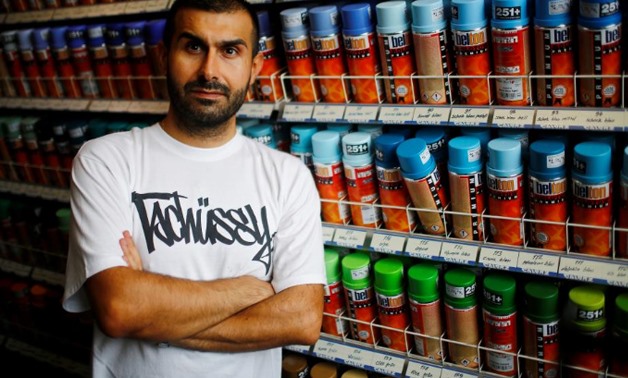
Graffiti artist Ibo Omari poses for a portrait in his shop in Berlin, Germany August 18, 2017.
REUTERS-Hannibal Hanschke
BERLIN – 21 August 2017: Horrified at the sight of swastikas scrawled on walls, children's playgrounds and building sites, a group of graffiti artists in Berlin is transforming the Nazi symbols into colorful artwork such as flowers, cars and animals.
The swastika, which was adopted by Adolf Hitler's Nazi party, is banned in Germany, where right-wing sentiment has risen due to an influx of more than a million migrants in the last two years.
Ibo Omari, who runs a graffiti shop and 'The Cultural Heirs' youth club, encourages young people to look out for swastikas in their local area and then creatively paint over them - after getting permission from whoever owns the defaced property.
"It was important to spur young people into action and to encourage them to take responsibility so they don't just ignorantly walk past such symbols of hatred," Omari told Reuters.
"It offends the whole neighborhood if someone in our midst paints swastikas in a children's playground and I take it personally," the 37-year-old said, adding that they also wanted to show graffiti had nothing to do with racism.
Omari and 'The Cultural Heirs' decided the best way to respond was "with humor and love" so they came up with designs such as rabbits, birds and a Rubik's Cube to cover swastikas.
Sketching potential designs during a graffiti workshop in Omari's shop, 16-year-old Philip Keilholz said he got involved as racism had no place in the cosmopolitan German capital.
"When tourists come to Berlin and look at a wall and see a swastika, they'll think: 'What's going on here? There are Nazis everywhere!' And we don't want that," he said.
"An artistic symbol obviously looks much nicer than an ugly message and then people walk through the city with a smile on their faces," he added.
The group has already transformed around 25 swastikas and their 'PaintBack' initiative has been copied by people in other cities including Hamburg, Kiel and Bremen.
Omari was shocked into starting the project in 2015 when a man came into his shop to get some cans of spray paint to cover a swastika in a park where he had been playing with his son. Two weeks later Omari heard about swastikas painted in a skate park.
"I felt like I was in the wrong film," said Omari. "There has been a shift towards the right in Germany and not just in Germany but in Europe overall ... so it's important to nail your colors to the mast."

Comments
Leave a Comment